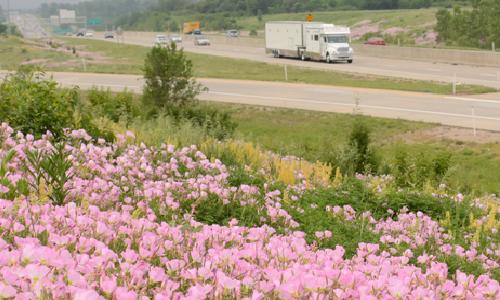The Kansas Department of Transportation’s successful roadside management policy is getting some well-deserved recognition each spring, as motorists enjoy the sight of pink evening primrose and other native wildflowers in full bloom along the state’s highways.
Background
KDOT’s roadside management policy encourages growth of native grasses and wildflowers on more than 150,000 acres of state-owned right-of-way.

KDOT environmental scientist Scott Shields said the agency began including native wildflowers in its seed mix in 2003-2004, and began to increase its focus on the native landscape even before that.
In 2008, KDOT staff and partners from conservation groups and the Kansas Department of Wildlife and Parks formed the Roadside Vegetation Task Force to focus on best practices for managing the state’s rights-of-way.
The resulting policy calls for seed blends that include native plants and wildflowers, use of certified mulch to prevent the spread of weeds, reduced mowing, and storing and replacing topsoil disturbed during construction.
Mowing Policy Revised
Most recently, KDOT revised its mowing policy, a practice that saves on fuel and labor costs while benefiting the environment. Mow-outs of the full right-of-way are done only once every four years instead of every three years, and are timed so the mowing does not interfere with late fall wildflower seed propagation. For the shoulders, mowers make only one pass and let the grass grow to 12 inches before cutting.
The agency also is stressing the importance of topsoil, requiring contractors to strip and store topsoil removed during construction. This practice helps to reestablish native plants and helps to control erosion.
Other practices include spot spraying rather than broadcasting of herbicides whenever possible.
Shields said the roadside vegetation management practices have been a big success. He noted the importance of educating maintenance and construction workers so that those in the field know what to do.
“As a result of these and other practices, we’ve reduced maintenance costs, provided erosion control, taken advantage of the vegetation’s natural filtration system and beautified our highways,” Shields said.
KDOT’s Northeast Kansas District Engineer Clay Adams, who led the task force, also noted the importance of such practices.
“Together we’ve developed a wiser approach to roadside management, we’ve found a way to stretch KDOT’s maintenance budget, and we now have guidelines that will enhance the natural beauty of our state,” Adams said.
The success of the policy can be seen each spring when native wildflowers – including purple rose verbena, white and yellow ox-eye daisy and yellow Missouri primrose – beautify the roadway while providing natural erosion control and filtration and habitat for pollinators and other wildlife.
For more information on KDOT’s roadside management practices, link to KDOT’s Roadside Management Brochure or contact Scott Shields at [email protected].

